trailer Peugeot 308 2015 Owner's Manual
[x] Cancel search | Manufacturer: PEUGEOT, Model Year: 2015, Model line: 308, Model: Peugeot 308 2015Pages: 416, PDF Size: 11.81 MB
Page 5 of 416
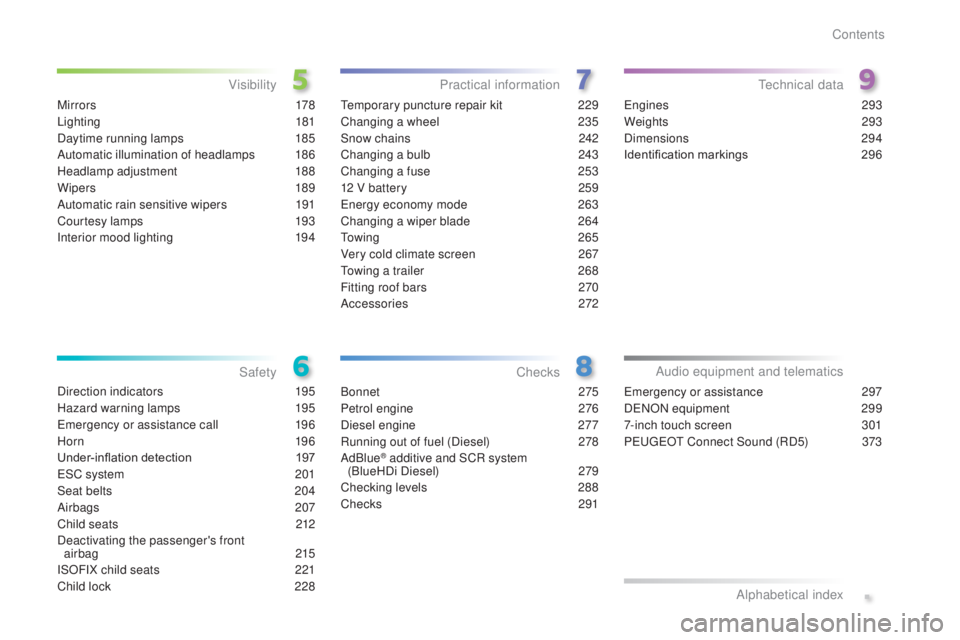
.
308_en_Chap00a_sommaire_ed01-2015
M i r r o r s 178
Lighting
181
Daytime running lamps
1
85
Automatic illumination of headlamps
1
86
Headlamp adjustment
1
88
Wipers
189
Automatic rain sensitive wipers
1
91
Courtesy lamps
1
93
Interior mood lighting
1
94te mporary puncture repair kit 2 29
Changing a wheel
2
35
Snow chains
2
42
Changing a bulb
2
43
Changing a fuse
2
53
12 V battery
2
59
en
ergy economy mode
26
3
Changing a wiper blade
2
64
to
w i n g
2 6 5
Very cold climate screen
2
67
to
wing a trailer
2
68
Fitting roof bars
2
70
Accessories
272
Bonnet
275
Petrol engine
2
76
Diesel engine
2
77
Running out of fuel (Diesel)
2
78
AdBlue
® additive and SCR system
(BlueHDi Diesel) 2 79
Checking levels
2
88
Checks
2
91
en
gines
293
Weights
2
93
Dimensions
2
94
Identification markings
2
96
Direction indicators
1
95
Hazard warning lamps
1
95
em
ergency or assistance call
1
96
Horn
19
6
Under-inflation detection 1
97
e
SC system
2
01
Seat belts
20
4
Airbags
207
Child seats
2
12
Deactivating the passenger's front airbag
215
ISOFIX child seats
2
21
Child lock
2
28
Visibility
Safety Practical information
Checkste chnical data
emergency or assistance 297
D
eN
ON equipment
2
99
7-inch touch screen
3
01
Peuge
O
t Connect Sound (RD5)
3
73
Audio equipment and telematics
Alphabetical index
Contents
Page 13 of 416
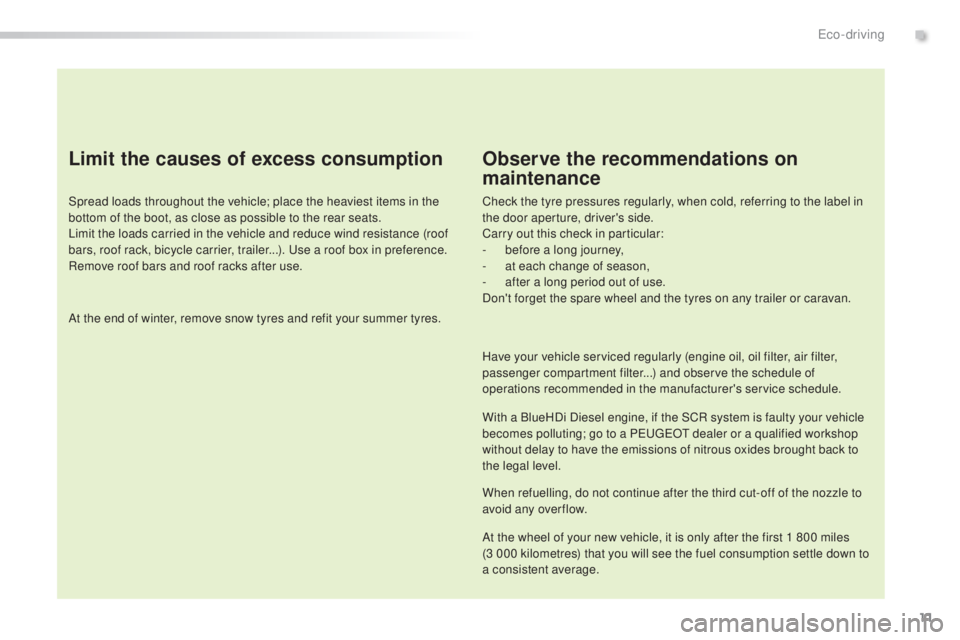
11
308_en_Chap00c_eco-conduite_ed01-2015
Limit the causes of excess consumption
Spread loads throughout the vehicle; place the heaviest items in the
bottom of the boot, as close as possible to the rear seats.
Limit the loads carried in the vehicle and reduce wind resistance (roof
bars, roof rack, bicycle carrier, trailer...). u
s
e a roof box in preference.
Remove roof bars and roof racks after use.
At the end of winter, remove snow tyres and refit your summer tyres.
Observe the recommendations on
maintenance
Check the tyre pressures regularly, when cold, referring to the label in
the door aperture, driver's side.
Carry out this check in particular:
-
b
efore a long journey,
-
a
t each change of season,
-
a
fter a long period out of use.
Don't forget the spare wheel and the tyres on any trailer or caravan.
Have your vehicle serviced regularly (engine oil, oil filter, air filter,
passenger compartment filter...) and observe the schedule of
operations recommended in the manufacturer's service schedule.
With a BlueHDi Diesel engine, if the SCR system is faulty your vehicle
becomes polluting; go to a P
e
uge
Ot
dealer or a qualified workshop
without delay to have the emissions of nitrous oxides brought back to
the legal level.
When refuelling, do not continue after the third cut-off of the nozzle to
avoid any over flow.
At the wheel of your new vehicle, it is only after the first 1 800 miles
(3 000 kilometres) that you will see the fuel consumption settle down to
a consistent average.
.
eco-driving
Page 166 of 416
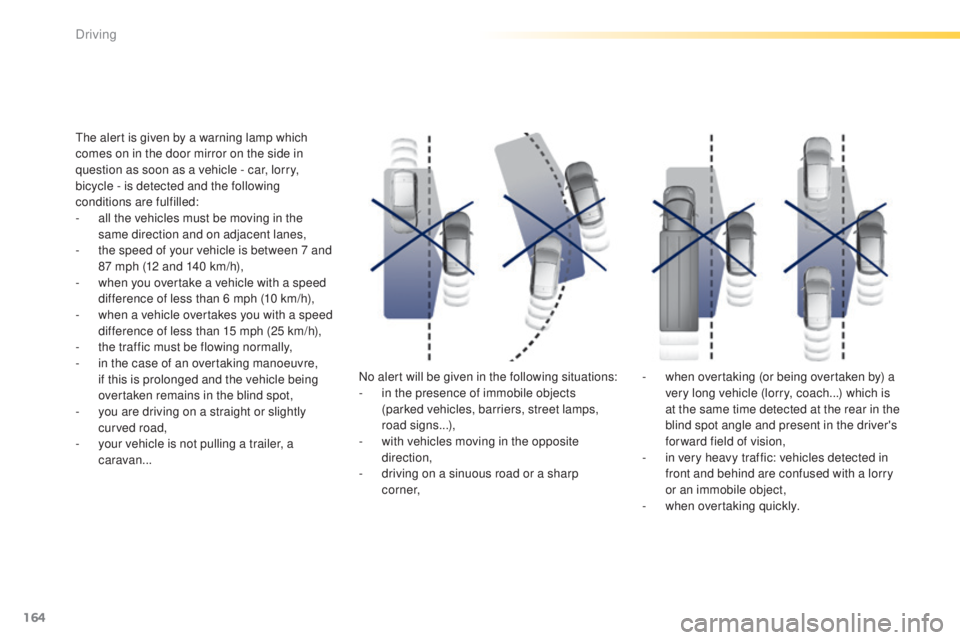
164
308_en_Chap04_conduite_ed01-2015
the alert is given by a warning lamp which
comes on in the door mirror on the side in
question as soon as a vehicle - car, lorry,
bicycle - is detected and the following
conditions are fulfilled:
-
a
ll the vehicles must be moving in the
same direction and on adjacent lanes,
-
t
he speed of your vehicle is between 7 and
87 mph (12 and 140 km/h),
-
w
hen you overtake a vehicle with a speed
difference of less than 6 mph (10 km/h),
-
w
hen a vehicle overtakes you with a speed
difference of less than 15 mph (25 km/h),
-
t
he traffic must be flowing normally,
-
i
n the case of an overtaking manoeuvre,
if this is prolonged and the vehicle being
overtaken remains in the blind spot,
-
y
ou are driving on a straight or slightly
curved road,
-
y
our vehicle is not pulling a trailer, a
caravan... No alert will be given in the following situations:
-
i
n the presence of immobile objects
(parked vehicles, barriers, street lamps,
road signs...),
-
w
ith vehicles moving in the opposite
direction,
-
d
riving on a sinuous road or a sharp
c o r n e r, -
w
hen overtaking (or being overtaken by) a
very long vehicle (lorry, coach...) which is
at the same time detected at the rear in the
blind spot angle and present in the driver's
forward field of vision,
-
i
n very heavy traffic: vehicles detected in
front and behind are confused with a lorry
or an immobile object,
-
w
hen overtaking quickly.
Driving
Page 169 of 416
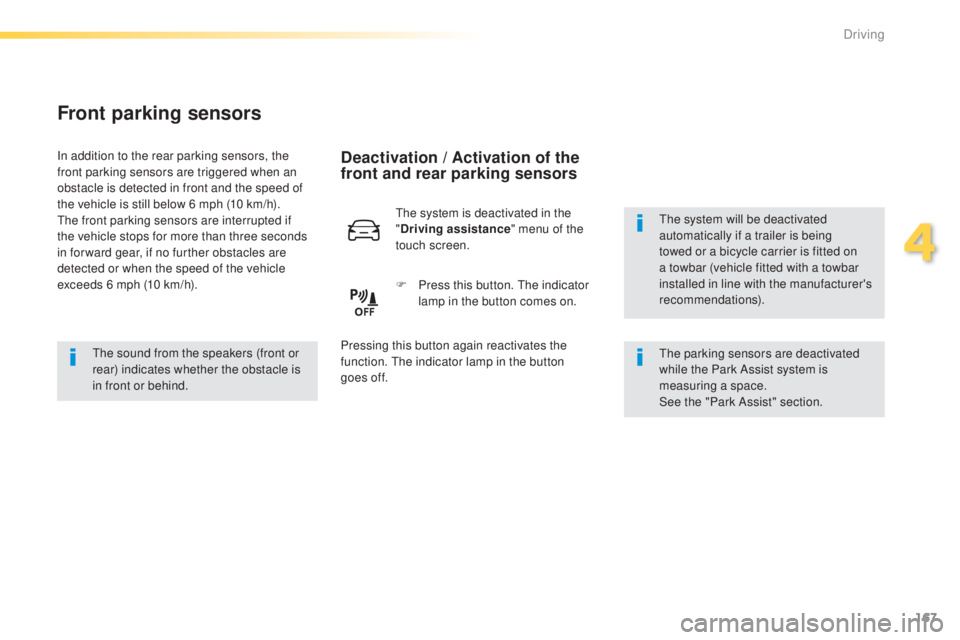
167
308_en_Chap04_conduite_ed01-2015
Front parking sensors
the sound from the speakers (front or
rear) indicates whether the obstacle is
in front or behind.
th
e system will be deactivated
automatically if a trailer is being
towed or a bicycle carrier is fitted on
a towbar (vehicle fitted with a towbar
installed in line with the manufacturer's
recommendations).
In addition to the rear parking sensors, the
front parking sensors are triggered when an
obstacle is detected in front and the speed of
the vehicle is still below 6 mph (10 km/h).
th
e front parking sensors are interrupted if
the vehicle stops for more than three seconds
in for ward gear, if no further obstacles are
detected or when the speed of the vehicle
exceeds 6 mph (10 km/h).
Deactivation / Activation of the
front and rear parking sensors
the system is deactivated in the
" Driving assistance " menu of the
touch screen.
F
P
ress this button. t
h
e indicator
lamp in the button comes on.
Pressing this button again reactivates the
function.
t
h
e indicator lamp in the button
goes
off.
the
parking sensors are deactivated
while the Park Assist system is
measuring a space.
See the "Park Assist" section.
4
Driving
Page 179 of 416
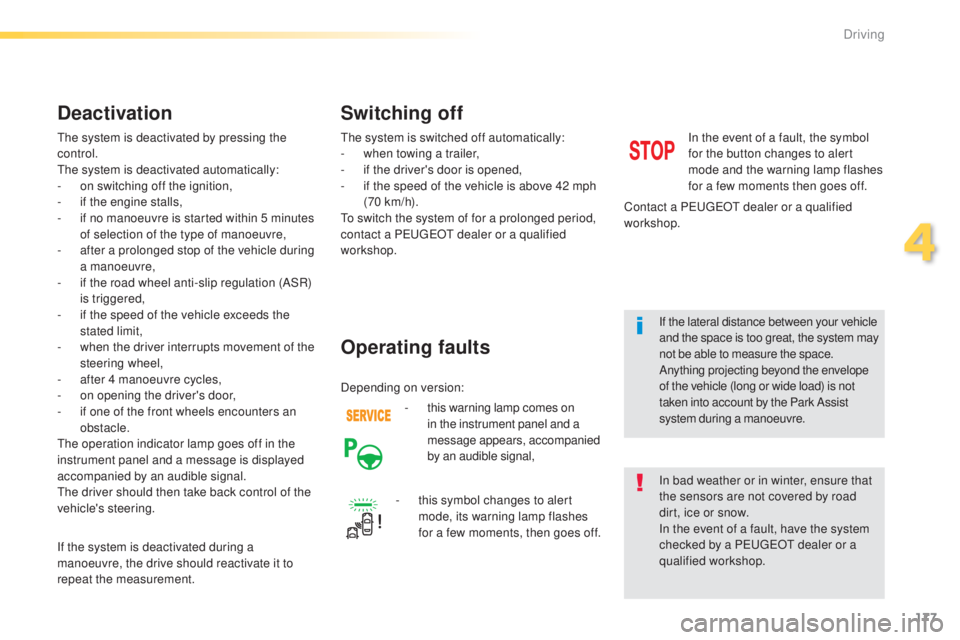
177
308_en_Chap04_conduite_ed01-2015
the system is deactivated by pressing the
control.
the
system is deactivated automatically:
-
o
n switching off the ignition,
-
i
f the engine stalls,
-
i
f no manoeuvre is started within 5 minutes
of selection of the type of manoeuvre,
-
a
fter a prolonged stop of the vehicle during
a manoeuvre,
-
i
f the road wheel anti-slip regulation (ASR)
is triggered,
-
i
f the speed of the vehicle exceeds the
stated limit,
-
w
hen the driver interrupts movement of the
steering wheel,
-
a
fter 4 manoeuvre cycles,
-
o
n opening the driver's door,
-
i
f one of the front wheels encounters an
obstacle.
th
e operation indicator lamp goes off in the
instrument panel and a message is displayed
accompanied by an audible signal.
th
e driver should then take back control of the
vehicle's steering.
Deactivation
If the system is deactivated during a
manoeuvre, the drive should reactivate it to
repeat the measurement.
th
e system is switched off automatically:
-
w
hen towing a trailer,
-
i
f the driver's door is opened,
-
i
f the speed of the vehicle is above 42 mph
(70 km/h).
to s
witch the system of for a prolonged period,
contact a P
e
uge
Ot
dealer or a qualified
workshop.
-
t
his warning lamp comes on
in the instrument panel and a
message appears, accompanied
by an audible signal,
Operating faults
In the event of a fault, the symbol
for the button changes to alert
mode and the warning lamp flashes
for a few moments then goes off.
Contact a P
e
uge
Ot
dealer or a qualified
workshop.
Switching off
In bad weather or in winter, ensure that
the sensors are not covered by road
dirt, ice or snow.
In the event of a fault, have the system
checked by a P
e
uge
Ot
dealer or a
qualified workshop.
-
t
his symbol changes to alert
mode, its warning lamp flashes
for a few moments, then goes off. If the lateral distance between your vehicle
and the space is too great, the system may
not be able to measure the space.
Anything projecting beyond the envelope
of the vehicle (long or wide load) is not
taken into account by the Park Assist
system during a manoeuvre.
Depending on version:
4
Driving
Page 270 of 416
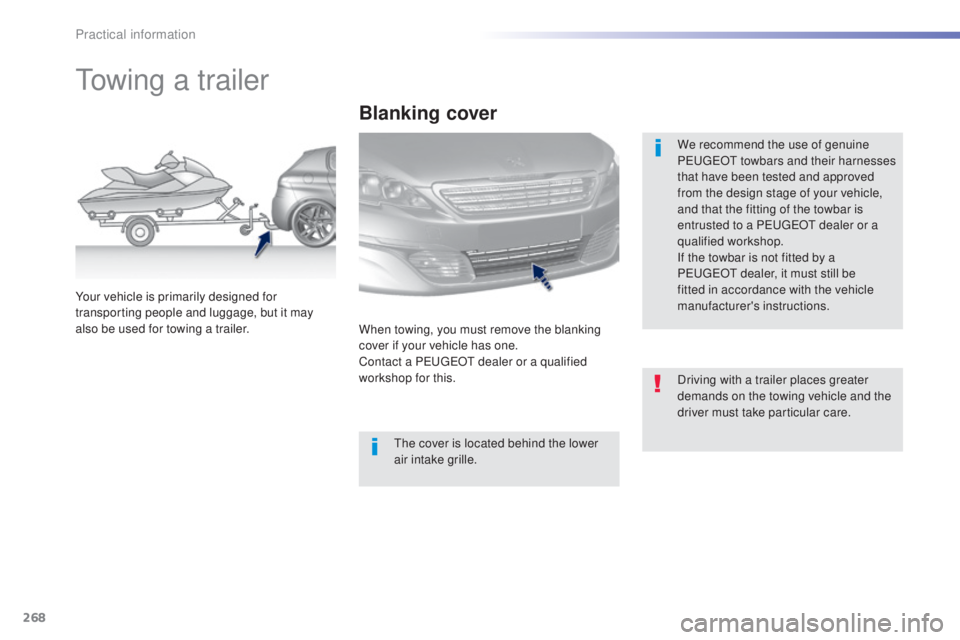
268
308_en_Chap07_info-pratiques_ed01-2015
towing a trailer
We recommend the use of genuine
PeugeOt towbars and their harnesses
that have been tested and approved
from the design stage of your vehicle,
and that the fitting of the towbar is
entrusted to a P
e
uge
Ot
dealer or a
qualified workshop.
If the towbar is not fitted by a
P
e
uge
Ot
dealer, it must still be
fitted in accordance with the vehicle
manufacturer's instructions.
Your vehicle is primarily designed for
transporting people and luggage, but it may
also be used for towing a trailer.
Blanking cover
When towing, you must remove the blanking
cover if your vehicle has one.
Contact a P
e
uge
Ot
dealer or a qualified
workshop for this. Driving with a trailer places greater
demands on the towing vehicle and the
driver must take particular care.
th
e cover is located behind the lower
air intake grille.
Practical information
Page 271 of 416

269
308_en_Chap07_info-pratiques_ed01-2015
Driving advice
Distribution of loads
F Distribute the load in the trailer so that the heaviest items are as close as possible to
the axle and the nose weight approaches
the maximum permitted without
exceeding
it.
Air density decreases with altitude, thus
reducing engine performance. Above
1
000 metres, the maximum towed load must
be reduced by 10
% for every 1 000 metres of
altitude.
Side wind
F take into account the increased sensitivity to side wind.
Cooling
towing a trailer on a slope increases the
temperature of the coolant.
As the fan is electrically controlled, its cooling
capacity is not dependent on the engine speed.
F
t
o l
ower the engine speed, reduce your
speed.
th
e maximum towed load on a long incline
depends on the gradient and the ambient
temperature.
In all cases, keep a check on the coolant
temperature.
F
I
f the warning lamp and the
STOP warning lamp come on,
stop the vehicle and switch off
the engine as soon as possible.
Braking
towing a trailer increases the braking distance.to a void overheating of the brakes on a long
mountain type of descent, the use of engine
braking is recommended.
Ty r e s
F Check the tyre pressures of the towing vehicle and of the trailer, observing the
recommended pressures.
Lighting
F Check the electrical lighting and signalling on the trailer.
Refer to the "
te
chnical data" section for
details of the weights and towed loads
which apply to your vehicle.
th
e rear parking sensors will be
deactivated automatically if a genuine
P
e
uge
Ot
towbar is used.
7
Practical information
Page 295 of 416
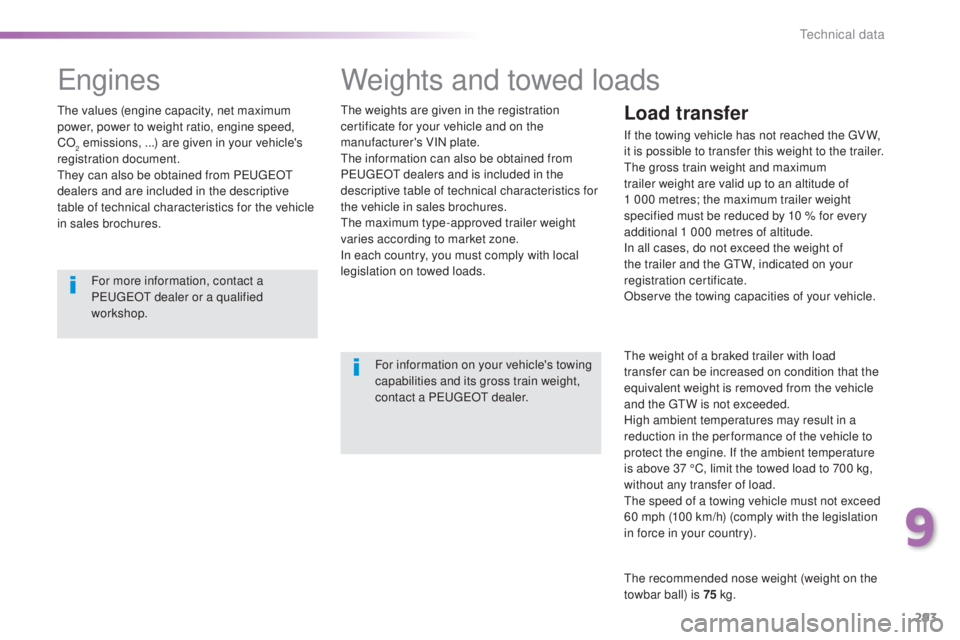
293
308_en_Chap09_caracteristiques-techniques_ed01-2015
Weights and towed loads
the weights are given in the registration
certificate for your vehicle and on the
manufacturer's VIN plate.
th
e information can also be obtained from
P
e
uge
Ot
dealers and is included in the
descriptive table of technical characteristics for
the vehicle in sales brochures.
th
e maximum type-approved trailer weight
varies according to market zone.
In each country, you must comply with local
legislation on towed loads.
For information on your vehicle's towing
capabilities and its gross train weight,
contact a P
e
uge
Ot
dealer.Load transfer
If the towing vehicle has not reached the gV W,
it is possible to transfer this weight to the trailer.
th
e gross train weight and maximum
trailer weight are valid up to an altitude of
1
000 metres; the maximum trailer weight
specified must be reduced by 10 % for every
additional 1
000 metres of altitude.
In all cases, do not exceed the weight of
the trailer and the
gt
W
, indicated on your
registration certificate.
Observe the towing capacities of your vehicle.
th
e weight of a braked trailer with load
transfer can be increased on condition that the
equivalent weight is removed from the vehicle
and the
gt
W i
s not exceeded.
High ambient temperatures may result in a
reduction in the per formance of the vehicle to
protect the engine. If the ambient temperature
is above 37 °C, limit the towed load to 700 kg,
without any transfer of load.
th
e speed of a towing vehicle must not exceed
60 mph (100 km/h) (comply with the legislation
in force in your country).
th
e recommended nose weight (weight on the
towbar ball) is 75 kg.
engines
the values (engine capacity, net maximum
power, power to weight ratio, engine speed,
CO
2 emissions, ...) are given in your vehicle's
registration document.
th
ey can also be obtained from P
e
uge
Ot
dealers and are included in the descriptive
table of technical characteristics for the vehicle
in sales brochures.
For more information, contact a
P
e
uge
Ot
dealer or a qualified
workshop.
9
technical data
Page 298 of 416
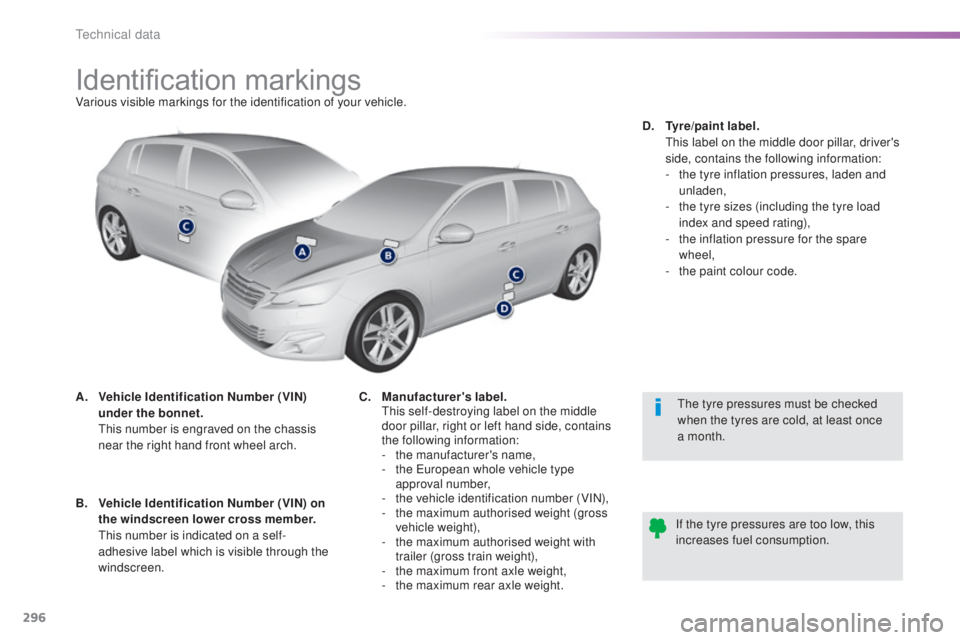
296
308_en_Chap09_caracteristiques-techniques_ed01-2015
Identification markingsVarious visible markings for the identification of your vehicle.
A.
V
ehicle Identification Number (VIN)
under the bonnet.
t
h
is number is engraved on the chassis
near the right hand front wheel arch.
th
e tyre pressures must be checked
when the tyres are cold, at least once
a month.
If the tyre pressures are too low, this
increases fuel consumption.
B.
V
ehicle Identification Number (VIN) on
the windscreen lower cross member.
t
h
is number is indicated on a self-
adhesive label which is visible through the
windscreen. C.
M
anufacturer's label.
t
h
is self-destroying label on the middle
door pillar, right or left hand side, contains
the following information:
-
t
he manufacturer's name,
-
t
he e
u
ropean whole vehicle type
approval number,
-
t
he vehicle identification number (VIN),
-
t
he maximum authorised weight (gross
vehicle weight),
-
t
he maximum authorised weight with
trailer (gross train weight),
-
t
he maximum front axle weight,
-
t
he maximum rear axle weight.D.
T
yre/paint label.
t
h
is label on the middle door pillar, driver's
side, contains the following information:
-
t
he tyre inflation pressures, laden and
unladen,
-
t
he tyre sizes (including the tyre load
index and speed rating),
-
t
he inflation pressure for the spare
wheel,
-
t
he paint colour code.
technical data
Page 415 of 416
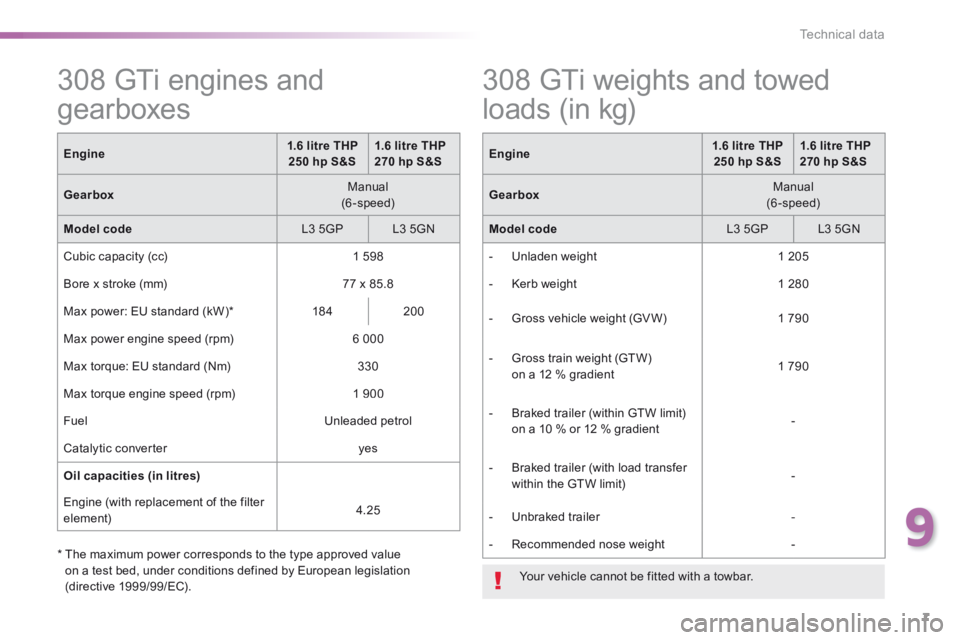
7
9
Technical data
308GTi_en_Chap09_caracteristiques-techniques_ed01-2015
308 GTi engines and
gearboxes
Engine1.6 litre THP 250 hp S&S1.6 litre THP 270 hp S&S
Gearbox Manual (6-speed)
Model code L3 5GP L3 5GN
Cubic capacity (cc) 1 598
Bore x stroke (mm) 77 x 85.8
Max power: EU standard (kW) * 18 4 200
Max power engine speed (rpm) 6 000
Max torque: EU standard (Nm) 330
Max torque engine speed (rpm) 1 900
Fuel Unleaded petrol
Catalytic converter yes
Oil capacities (in litres)
Engine (with replacement of the filter element) 4.25
* The maximum power corresponds to the type approved value on a test bed, under conditions defined by European legislation
(directive 1999/99/EC).
308 GTi weights and towed
loads (in kg)
Engine1.6 litre THP 250 hp S&S1.6 litre THP 270 hp S&S
Gearbox Manual (6-speed)
Model code L3 5GP L3 5GN
- Unladen weight 1 205
- Kerb weight 1 280
- Gross vehicle weight (GV W) 1 790
- Gross train weight (GTW) on a 12 % gradient 1 790
- Braked trailer (within GTW limit) on a 10 % or 12 % gradient -
- Braked trailer (with load transfer within the GTW limit) -
- Unbraked trailer -
- Recommended nose weight -
Your vehicle cannot be fitted with a towbar.